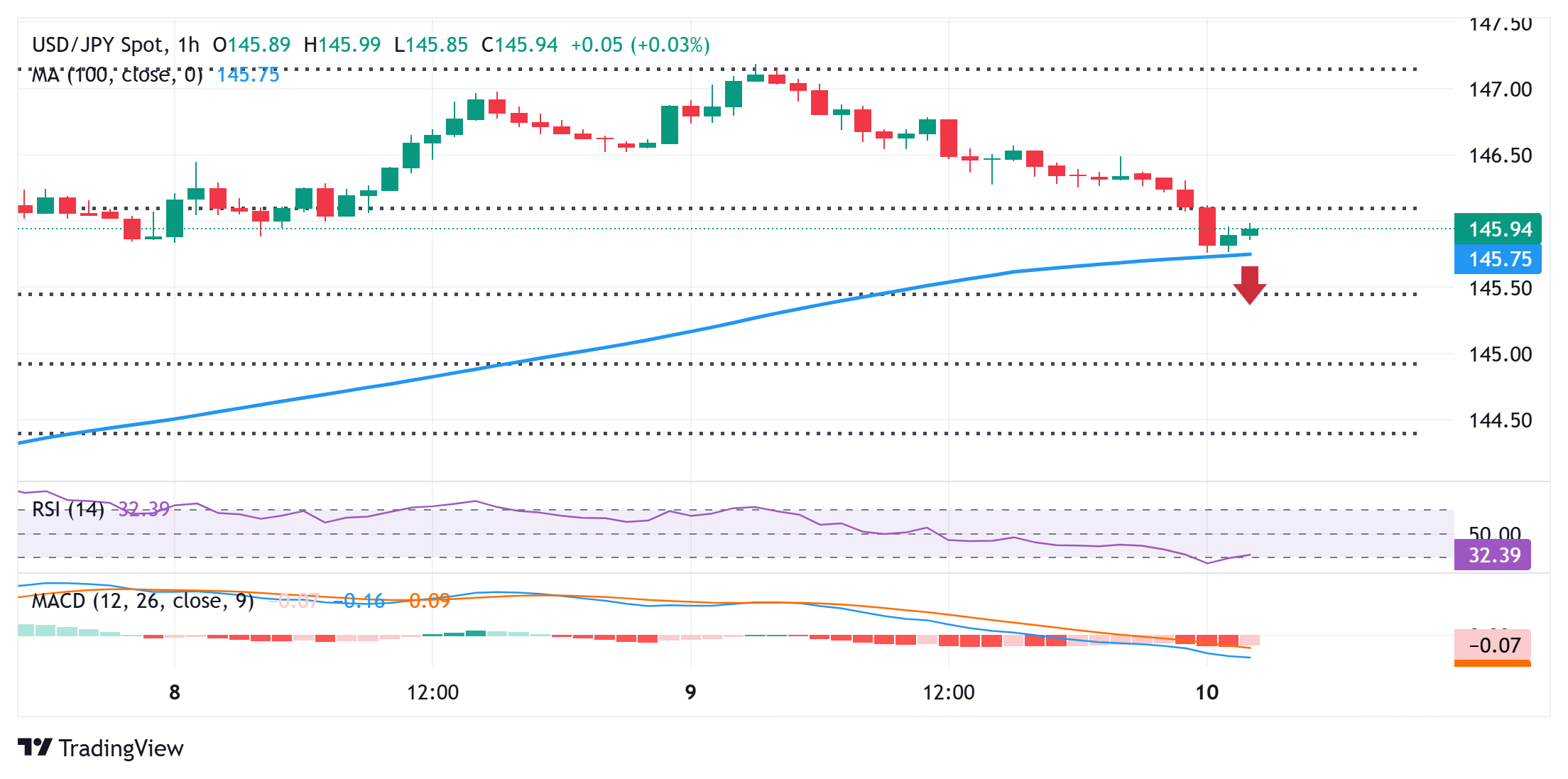Created
: 2025.07.10














![]() 2025.07.10 11:36
2025.07.10 11:36
The Japanese Yen (JPY) is building on the previous day's goodish recovery from over a two-week low and scaling higher for the second consecutive day against a broadly retreating US Dollar (USD). Investors remain on edge amid persistent uncertainties surrounding US President Donald Trump's trade policies, which, in turn, benefit the safe-haven JPY. The USD, on the other hand, is undermined by prospects for more interest rate cuts by the Federal Reserve (Fed) this year, bolstered by FOMC Minutes on Wednesday. This, in turn, contributes to the USD/JPY pair's intraday slide back below the 146.00 round figure during the Asian session.
Meanwhile, investors now seem convinced that rising trade tensions would add to woes for Japan's economy and force the Bank of Japan (BoJ) to forgo raising interest rates this year. The expectations were reaffirmed by Japan's Producer Price Index (PPI) released earlier this Thursday, which hinted that inflation pressures might be cooling off. This, along with domestic political uncertainty, might hold back the JPY bulls from placing aggressive bets and help limit further losses for the USD/JPY pair. Traders now look to the US Weekly Initial Jobless Claims, which, along with speeches by influential FOMC members, would drive the Greenback.

From a technical perspective, intraday breakdown below the 23.6% Fibonacci retracement level of the recent move up from the monthly swing low could be seen as a key trigger for the USD/JPY bears. The subsequent fall, however, finds some support near the 145.75 region, representing the 100-hour Simple Moving Average (SMA). The said area should now act as a pivotal point, below which spot prices could extend the fall towards the 38.2% Fibo. retracement level, around the 145.50-145.45 area. Some follow-through selling could eventually drag the pair to the next relevant support near the 145.00 psychological mark, or the 50% retracement level.
On the flip side, any recovery beyond the 146.00 mark might now confront resistance near the 146.25-146.30 area ahead of the 146.55 region. A sustained strength beyond the latter will suggest that the corrective pullback has run its course and allow the USD/JPY pair to reclaim the 147.00 round figure. The momentum could extend further towards the 147.60-147.65 intermediate hurdle en route to the 148.00 mark, or the June monthly swing high.
Tariffs are customs duties levied on certain merchandise imports or a category of products. Tariffs are designed to help local producers and manufacturers be more competitive in the market by providing a price advantage over similar goods that can be imported. Tariffs are widely used as tools of protectionism, along with trade barriers and import quotas.
Although tariffs and taxes both generate government revenue to fund public goods and services, they have several distinctions. Tariffs are prepaid at the port of entry, while taxes are paid at the time of purchase. Taxes are imposed on individual taxpayers and businesses, while tariffs are paid by importers.
There are two schools of thought among economists regarding the usage of tariffs. While some argue that tariffs are necessary to protect domestic industries and address trade imbalances, others see them as a harmful tool that could potentially drive prices higher over the long term and lead to a damaging trade war by encouraging tit-for-tat tariffs.
During the run-up to the presidential election in November 2024, Donald Trump made it clear that he intends to use tariffs to support the US economy and American producers. In 2024, Mexico, China and Canada accounted for 42% of total US imports. In this period, Mexico stood out as the top exporter with $466.6 billion, according to the US Census Bureau. Hence, Trump wants to focus on these three nations when imposing tariffs. He also plans to use the revenue generated through tariffs to lower personal income taxes.
![]()
Created
: 2025.07.10
![]()
Last updated
: 2025.07.10

FXStreet is a forex information website, delivering market analysis and news articles 24/7.
It features a number of articles contributed by well-known analysts, in addition to the ones by its editorial team.
Founded in 2000 by Francesc Riverola, a Spanish economist, it has grown to become a world-renowned information website.
We hope you find this article useful. Any comments or suggestions will be greatly appreciated.
We are also looking for writers with extensive experience in forex and crypto to join us.
please contact us at [email protected].
Disclaimer:
All information and content provided on this website is provided for informational purposes only and is not intended to solicit any investment. Although all efforts are made in order to ensure that the information is correct, no guarantee is provided for the accuracy of any content on this website. Any decision made shall be the responsibility of the investor and Myforex does not take any responsibility whatsoever regarding the use of any information provided herein.
The content provided on this website belongs to Myforex and, where stated, the relevant licensors. All rights are reserved by Myforex and the relevant licensors, and no content of this website, whether in full or in part, shall be copied or displayed elsewhere without the explicit written permission of the relevant copyright holder. If you wish to use any part of the content provided on this website, please ensure that you contact Myforex.
Myforex uses cookies to improve the convenience and functionality of this website. This website may include cookies not only by us but also by third parties (advertisers, log analysts, etc.) for the purpose of tracking the activities of users. Cookie policy